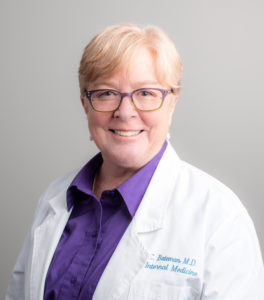The Bateman Horne Center is always excited to share important research on ME/CFS and FM happening around the globe. Today, we focus on David Systrom, a pulmonary and critical care physician who researches all forms of exercise intolerance and heads, by request of the Massachusetts General Hospital, the Invasive Cardiopulmonary Exercise Lab in Boston. He is also a physician at Brigham and Women’s Hospital, and an assistant professor of Medicine at Harvard Medical School. The content for this post is taken from a recent interview with David Systrom on ME/CFS Alert, which can be found as an embedded video at the end of this post.
Systrom’s research uses invasive cardiopulmonary exercise to measure types of fatigue and exercise intolerance that are difficult or impossible to measure while the patient is at rest. The cardiopulmonary aspect is measured by a 6-8 minute cycling test where the patient pedals to exhaustion; the invasive aspect is the two catheters inserted into veins in the arm and neck, which take key readings when the patient is at rest, exercising, at peak exercise, and an hour after exercise.
From this research, Systrom has uncovered several key findings. First, a phenomenon called internal preload failure – the inability or unwillingness of large veins in the legs, abdomen, and pelvis to push blood up to the right side of the heart – is ubiquitous for ME/CFS patients.
 Second, the vast majority of his ME/CFS patients struggle with dysfunctional systematic oxygen exchange or extraction, which means that there are problems with how blood goes out to muscles, gets redirected to muscle fiber mitochondria, and comes back to the heart. Alternatively, it is hypothesized that there may instead be problems with how the mitochondria absorb the needed oxygen from the blood.
Second, the vast majority of his ME/CFS patients struggle with dysfunctional systematic oxygen exchange or extraction, which means that there are problems with how blood goes out to muscles, gets redirected to muscle fiber mitochondria, and comes back to the heart. Alternatively, it is hypothesized that there may instead be problems with how the mitochondria absorb the needed oxygen from the blood.
This line of research does not exclude other lines of ME/CFS research, such as T-cell function and viral infections. For instance, the symptoms noted here may be the result of a chronic viral infection.
Systrom also discussed small fiber polyneuropathy, which has 40% prevalence in patients with fibromyalgia and POTS, and 40-50% prevalence in patients with ME/CFS and preload failure. Small fiber polyneuropathy is involved with pain, and is believed to be a primitive part of the neurologic system. When these damaged fibers misfire, they trigger neuropathic pain, arthralgia, and pain in the muscles and skeleton.
Systrom believes that ME/CFS, preload failure syndrome, and oxygen extraction failure may all be mediated by imbalance between the sympathetic and parasympathetic nerves of the autonomic nervous system.
Systrom’s vision for the big picture of future research into exercise intolerance begins with getting NIH to realize the scope of the problem, and continues with recruiting large centers with expertise to spearhead the research. Since exercise intolerance and related illnesses such as ME/CFS and FM are complex and multifaceted, high levels of communication are necessary between many centers and many disciplines. Thus, facilitating cross-talk is a key strategy for advancing the research on ME/CFS and FM. In more individual news, his group will be an integral part of the Harvard Chronic Fatigue Center, and is about to launch a “double blind placebo controlled prospective study . . . with our go-to medication, at least at the moment, of pyridostigmine.”
Pyridostigmine is an FDA-approved drug that he has used off-label to treat approximately 300 patients, most of them women with ME/CFS. Systrom reports that there is objective and subjective evidence to suggest that the vast majority of these patients improve. This medication appears to promote healthy interaction between the autonomic nervous system and vascular bed, which affects preload failure. Additionally, it “favorably affects the vascular distribution of cardiac output out to the limb skeletal muscles, and in particular the slow twitch muscle fibers where the mitochondria are.” Further, although unproven, the medicine may help reduce inflammation and boost the immune system.
Finally, Systrom advised people without easy access to hospital treatment of ME/CFS or FM to get in touch with nonprofits like BHC, who are currently far ahead of the government and the rest of the medical community when it comes to patient resources.
While the Bateman Horne Center does not currently have a list of doctors patients can visit, we are working hard to educate the medical community about the reality and significance of ME/CFS and FM so that first class medical care becomes the standard, not the exception, for these diseases. We invite you to join with us to advance biomarker research, educate healthcare providers, and host expert consultations and targeted clinical trials to work toward a world where ME/CFS and Fibromyalgia are readily diagnosed, effectively treated, and widely met with empathy and understanding.
If you would like to support the Bateman Horne Center as we continue important research on the workings of ME/CFS and FM, we invite you to follow us on Facebook, Twitter, or Instagram, sign up for our newsletter, or make a donation today. We thank you for your continued patience, compassion, and support.

 Lucinda Bateman, MD, is a renowned clinician, researcher, and educator. Her Johns Hopkins University Medical School training instilled an approach to care that she has employed throughout her career - the patient comes first and the unknown or unexplained does not equate to a lack of proper and compassionate care. Since starting her own practice in 2000, she has served on six boards or committees, been the principal investigator for 45 studies, authored/coauthored 40 journal articles, served as adjunct instructor and adjunct assistant professor in the University of Utah Departments of Preventative Medicine, Internal Medicine, and Anesthesiology, and lectured around the world.
Lucinda Bateman, MD, is a renowned clinician, researcher, and educator. Her Johns Hopkins University Medical School training instilled an approach to care that she has employed throughout her career - the patient comes first and the unknown or unexplained does not equate to a lack of proper and compassionate care. Since starting her own practice in 2000, she has served on six boards or committees, been the principal investigator for 45 studies, authored/coauthored 40 journal articles, served as adjunct instructor and adjunct assistant professor in the University of Utah Departments of Preventative Medicine, Internal Medicine, and Anesthesiology, and lectured around the world.